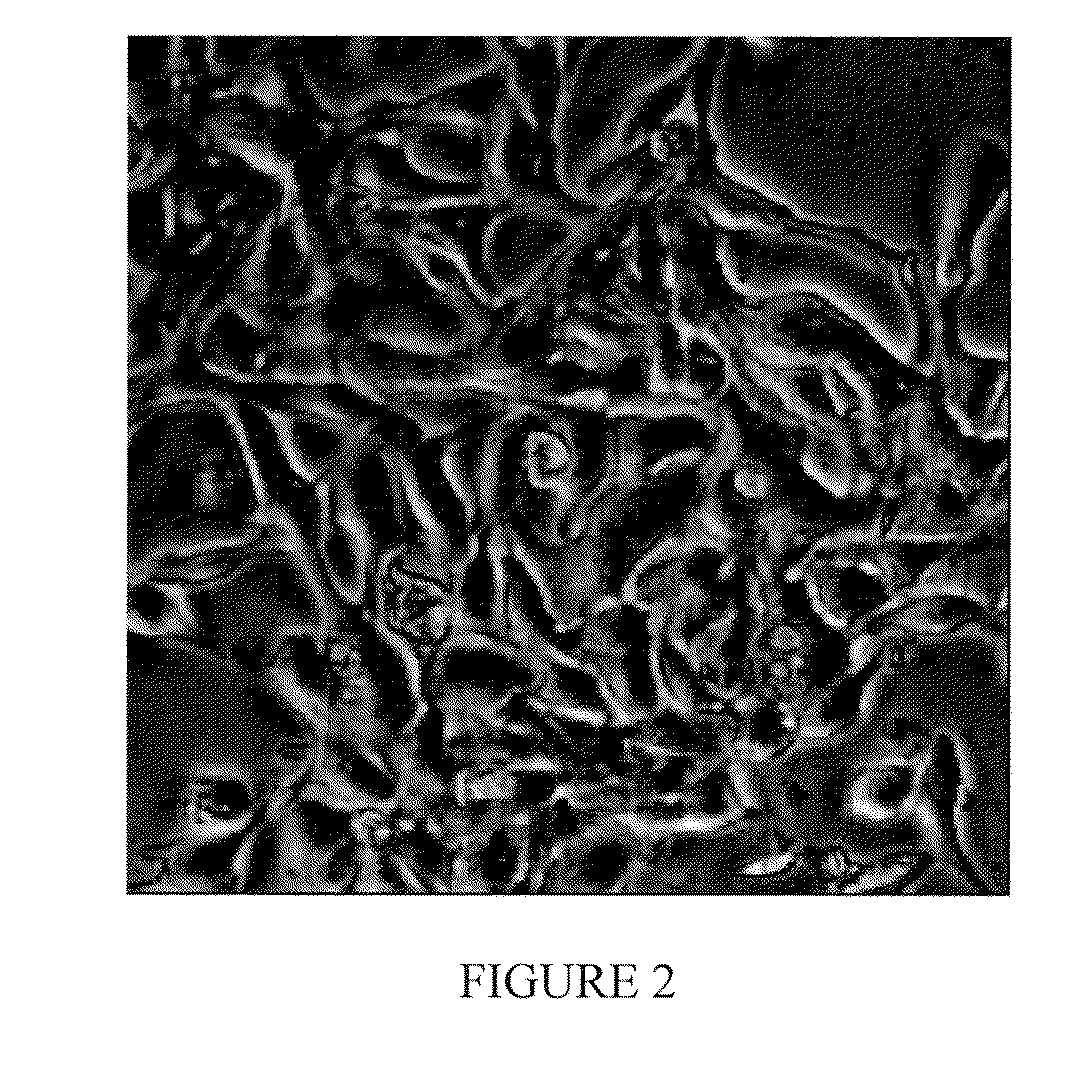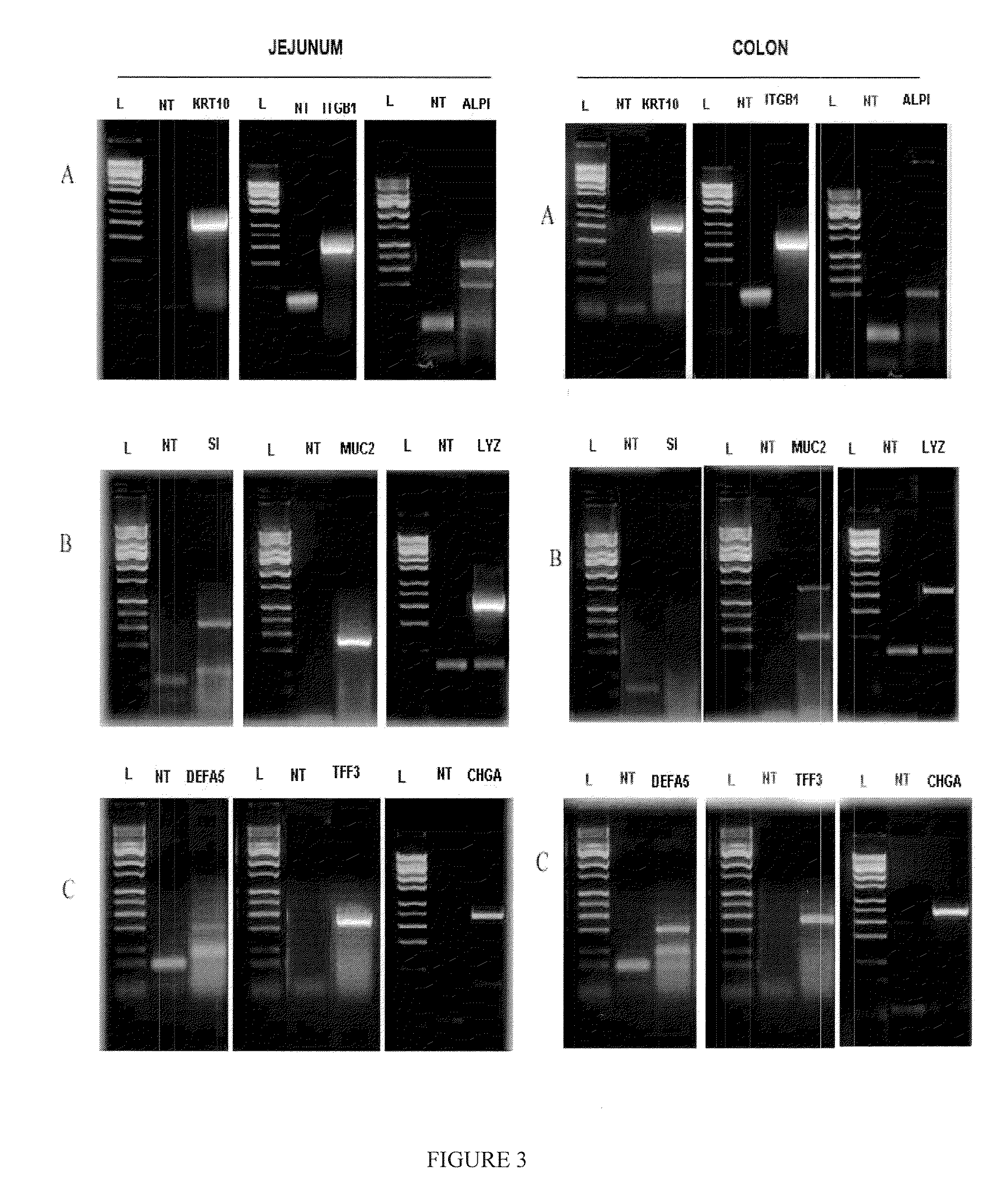Drug Discovery Methods Involving A Preclinical, In Vitro Isolated Gastrointestinal Epithelial Stem Cell-Like Progenitor Cell System
a progenitor cell and in vitro technology, applied in the field of drug discovery methods, can solve the problems of loss of biological activity or toxicity, limiting affecting the absorption rate of drugs,
- Summary
- Abstract
- Description
- Claims
- Application Information
AI Technical Summary
Benefits of technology
Problems solved by technology
Method used
Image
Examples
example 1
Isolation of Human Gastrointestinal Epithelial Segment-Specific Stem-Cell-Like Progenitor Cells
Example 1(a)
Tissue Isolation
[0137]Tissue from resected specimens or biopsies from various segments of the gastrointestinal tract (from the mouth to the rectum) were transported from an operating room to the laboratory either in University of Wisconsin medium (UW), normal saline or in RPMI medium supplemented with antibiotics (penicillin (100 Units / ml and streptomycin (100 μg / ml) (Gibco)) in wet ice within 24 hours from the removal of the specimen. The specimens were rinsed vigorously in sterile phosphate buffered saline (1×), pH 7.4 (PBS) (Invitrogen, Carlsbad, Calif.; Catalog No. 10010-023) to remove loosely adherent material, gently rubbed with sterile gauze, and washed at least ten times in PBS supplemented with antibiotic (1% penicillin / streptomycin) (ICN Biomedical, Costa Mesa, Calif.) and antimycotic (1% Fungizone) (“supplemented PBS”).
[0138]The mucosa was stripped off by careful dis...
example 1 (
Example 1(c)
Cell Isolation
[0140]The remaining tissue pieces were processed for isolation of surface and crypt epithelial cells by using sequential protease (dispase) treatments.
[0141]Mucosal tissue segments were treated with dispase solution (0.5 mg / ml in RPMI 1406 (Invitrogen, Carlsbad, Calif.)) six times for 5 minutes, 15 minutes, 20 minutes, 20 minutes, 30 minutes, and 30 minutes, respectively, each in an orbital shaker at 37° C. At each interval, the cell suspensions were collected and the solution evaluated for the presence of progenitor stem-cell-like crypt epithelial cells that were liberated from the mucosal pieces by the dispase treatments. Histological examination of the sample tissue pieces after each dispase treatment was performed. Hematoxylin and eosin (Sigma Aldrich, St. Louis, Mo.) staining of the histologic segments demonstrated that the surface epithelium was completely removed by the first two dispase treatments with maintenance of the crypt epithelium. After the ...
example 2
Formation of Bio-Similar-Matrix-Environments (BSMEs) on Plastic Surfaces
[0142]The de-epithelialized mucosal tissues remaining after the dispase treatment of Example 1 were collected and homogenized in PBS (1 ml / 1 mg tissue). A cocktail of protease inhibitors, which included PMSF (1 mM), Aprotinin (0.15 units / ml), Lenpeptin (5 μg / ml), Pepstatin (1 μg / ml) and fluoride (1 mM), was added to the homogenate (0.5 ml of protease inhibitor cocktail for 20 grams of tissue lysate) to prevent degradation of matrix protein substances that may provide anchorage and / or support for epithelial growth. The protein concentration of this mucosal tissue homogenate was determined by Bradford protein assay (Sigma-Aldrich, St. Louis, Mo.) then was diluted into 1 mg / ml in RPMI medium (Invitrogen, Carlsbad, Calif.) and used to coat the surfaces of plastic Petri dishes for 30 minutes to thereby form a bio-similar-matrix-environment on the plastic surface. In some cases, human collagen type IV (10 μg / ml) (Sigm...
PUM
| Property | Measurement | Unit |
|---|---|---|
| Permeability | aaaaa | aaaaa |
| Electrical resistance | aaaaa | aaaaa |
| Permeability | aaaaa | aaaaa |
Abstract
Description
Claims
Application Information
 Login to View More
Login to View More - R&D
- Intellectual Property
- Life Sciences
- Materials
- Tech Scout
- Unparalleled Data Quality
- Higher Quality Content
- 60% Fewer Hallucinations
Browse by: Latest US Patents, China's latest patents, Technical Efficacy Thesaurus, Application Domain, Technology Topic, Popular Technical Reports.
© 2025 PatSnap. All rights reserved.Legal|Privacy policy|Modern Slavery Act Transparency Statement|Sitemap|About US| Contact US: help@patsnap.com



